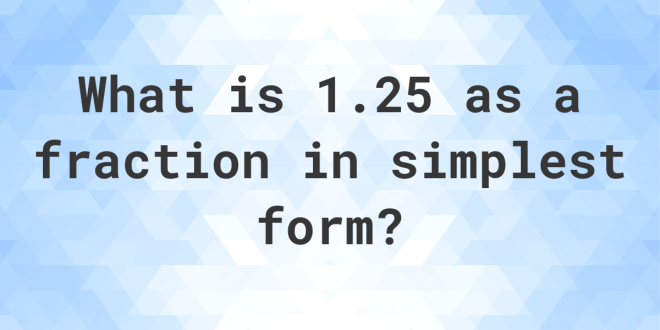Fractions are an essential part of mathematics, representing numbers that are not whole or integer values. They allow us to express quantities that fall between whole numbers, providing a more precise representation of measurements, ratios, and proportions. In this article, we will delve into the fraction 1.25 and explore its representation, properties, and applications.
Expressing 1.25 as a Fraction
To express 1.25 as a fraction, we need to understand the concept of decimal fractions. The decimal representation of a number shows its value in terms of powers of 10. In the case of 1.25, it can be written as 1 unit plus 2 tenths plus 5 hundredths. To convert this decimal to a fraction, we can use place value.
The decimal fraction 1.25 can be written as the fraction 125/100. However, this fraction can be simplified further by dividing both the numerator and denominator by their greatest common divisor, which is 25. Thus, 1.25 simplifies to 5/4.
Properties of 1.25 as a Fraction
Now that we have expressed 1.25 as the fraction 5/4, let’s explore its properties. The numerator, which is 5, represents the number of parts we have, while the denominator, which is 4, represents the total number of equal parts that make up a whole.
One interesting property of 1.25 as a fraction is that it is an improper fraction. An improper fraction is one where the numerator is equal to or greater than the denominator. In this case, the numerator (5) is greater than the denominator (4). Improper fractions can be converted to mixed numbers, which consist of a whole number and a proper fraction. In the case of 5/4, it can be written as 1 and 1/4.
Equivalent Fractions
Equivalent fractions are fractions that represent the same value but are written differently. To find equivalent fractions of 1.25, we can multiply or divide both the numerator and denominator by the same non-zero number. For example, multiplying 5/4 by 2 gives us 10/8, which is an equivalent fraction.
Another way to find equivalent fractions is by simplifying the fraction. In the case of 5/4, we can divide both the numerator and denominator by their greatest common divisor, which is 1. This results in an equivalent fraction of 5/4.
Applications of 1.25 as a Fraction
Fractions are used in various real-life scenarios, and 1.25 as a fraction can be applied in many contexts. For instance, in cooking recipes, measurements often require fractions. If a recipe calls for 1.25 cups of flour, it means you need 5/4 cups of flour. Similarly, in construction or woodworking, fractions are used to measure lengths, widths, and heights of materials.
Furthermore, fractions are crucial in financial calculations. If you have $1.25 and want to divide it equally among four people, each person would receive 5/4 dollars. Fractions are also used in statistics to represent probabilities and proportions.
Conclusion:
Understanding fractions is fundamental to mathematics and has practical applications in various fields. The fraction 1.25, when expressed as 5/4, represents a value between one and two. By exploring its properties, equivalent fractions, and applications, we can appreciate the significance of fractions in our everyday lives. Whether it’s in cooking, construction, finance, or statistics, fractions like 1.25 help us achieve accuracy and precision in our calculations.
 HammBurg Be informed with latest news, reviews, entertainment, lifestyle tips, and much more.
HammBurg Be informed with latest news, reviews, entertainment, lifestyle tips, and much more.




